
Xujiahui is a locality in Shanghai. It is a historic area of commerce and culture administratively within Xuhui District, which is named after the locality. The area is a well-known precinct for shopping and entertainment in Shanghai. It is served by the Xujiahui Station of the Shanghai Metro.

Xuhui District is a core urban district of Shanghai. It has a land area of 54.76 km2 (21.14 sq mi) and a population of 982,200 as of 2008.

Puxi is the historic center of Shanghai, China, and remains the home of approximately 48% of Shanghai's residents in an area of 288 km². Puxi is distinguished from Pudong to its east, which is separated from it by the Huangpu River. Despite the growing importance of Pudong's Lujiazui area, Puxi remains Shanghai's cultural, residential and commercial center.

St. Ignatius Cathedral, also known as the Xujiahui Cathedral or the Xujiahui Catholic Church, is a Roman Catholic cathedral, located in Xujiahui, Shanghai, China. Since 1960, St Ignatius has been the seat of the Bishop of Shanghai and the headquarters of the Roman Catholic Diocese of Shanghai. It was designed in the Neo-Gothic style by William Doyle and built between 1906 and 1910.

Pierre Marie Heude was a French Jesuit missionary and zoologist.
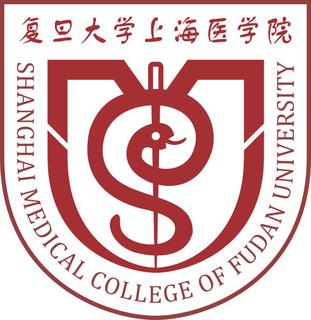
The Shanghai Medical College, Fudan University, formerly the independent Shanghai Medical University (SHMU), is one of the oldest and most prestigious medical schools in China. Clinical medicine of the Shanghai Medical College of Fudan University is consistently ranked among the top three medical schools in China and #45 globally by Times Higher Education World University Rankings as of 2022. Its "Clinical Medicine" also ranked #73 globally by the U.S. News & World Report globally.

Line 1 is a north-south line of the Shanghai Metro. It runs from Fujin Road in the north, via Shanghai Railway Station to Xinzhuang in the south. The first line to open in the Shanghai Metro system, line 1 serves many important points in Shanghai, including People's Square and Xujiahui. Due to the large number of important locations served, this line is extremely busy, with a daily ridership of over 1,000,000 passengers. Generally, the line runs at grade beside the Shanghai–Hangzhou railway in the south, underground in the city center and elevated on the second deck of the North–South Elevated Road in the North. The line is colored red on system maps.

Hengshan Road, formerly Avenue Pétain, is a street in the former French Concession of Shanghai, China. A major thoroughfare that connected the heart of the French Concession with the Catholic district of Zikawei (Xujiahui), the boulevard was for much of the 20th century the centre of Shanghai's premier residential district. Since the 1990s, many of the mansions along the road have been converted into bars, night clubs, and restaurants. From 2016 onward, many of the bars on Hengshan Road have been closed down or moved away to other new and more popular entertainment districts in the city.

Grand Gateway Shanghai is an office complex consisting of two identical skyscrapers in the Xujiahui area of Shanghai, China. It was completed in 2005.
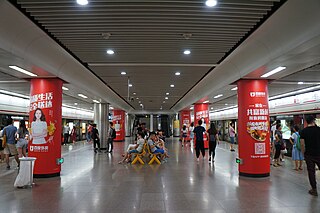
Xujiahui is an interchange station between lines 1, 9 and 11 of the Shanghai Metro. It is located in the Xujiahui area of Xuhui District, Shanghai. The station is one of the busiest in the metro system, and is extremely crowded during peak hours. Six large shopping malls and eight large office towers are each within no more than a three-minute walk of one of the station's exits. The station has a total of 20 exits, more than any other subway station in Shanghai.

The Shanghai Library, which also houses the Shanghai Institute of Scientific and Technological Information, is the municipal library of Shanghai, China. It is the largest library in China. At 24 stories and 348 feet tall, it is the second tallest library in the world after the National Library of Indonesia in Jakarta, as well as one of the largest. The building has a tower that resembles a lighthouse.

The Shanghai French Concession was a foreign concession in Shanghai, China from 1849 until 1943, which progressively expanded in the late 19th and early 20th centuries. The concession came to an end in 1943, when Vichy France under German pressure signed it over to the pro-Japanese Reorganized National Government of China in Nanjing. For much of the 20th century, the area covered by the former French Concession remained the premier residential and retail district of Shanghai, and was also one of the centres of Catholicism in China. Despite re-development over the last few decades, the area retains a distinct character and is a popular tourist destination.
Shanghai Southwest Weiyu Middle School, is a private school situated on Yishan Road in Xuhui District, Shanghai, PRC. Founded in 1993, it is the first large-scale private middle school in Chinese mainland since the adoption of the reform and opening up policy. The school is sponsored by Shanghai Xujiahui Department Group Store Company Ltd.
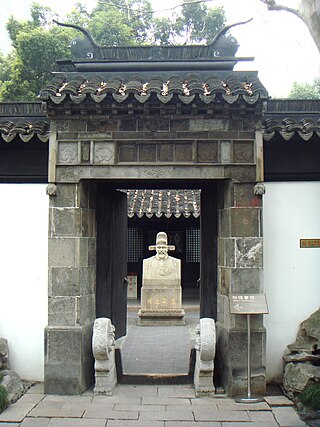
The Xu Guangqi Memorial Hall (徐光启纪念馆) is a memorial and museum for the 17th-century Chinese scholar Xu Guangqi. It is located besides the tomb of Xu Guangqi in Guangqi Park (光启公园), Xujiahui, Xuhui District, Shanghai, China. Formerly Nandan Park (南丹公园), the park was renamed in 1983 for the 350th anniversary of Xu Guangqi's death.
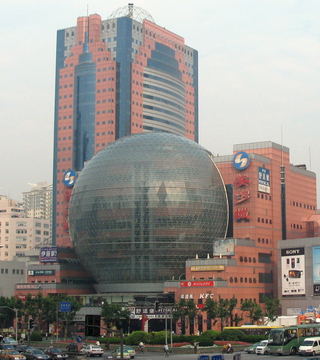
Metro-City is a shopping mall in the Xujiahui area of Shanghai, China. It was built in 1989 and serves as one of the landmarks of the area, much because of the surrounding gigantic hemispherical structure that glows by evening.
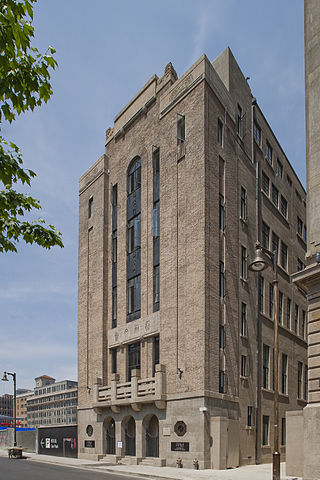
The Rockbund Art Museum is a contemporary art museum in central Shanghai. The museum is on Huqiu Road, in the former Royal Asiatic Society building completed in 1933 near The Bund waterfront. The museum is dedicated to being an influential, innovative, sustainable organization devoted to the promotion of projects within the field of international contemporary art. There are no permanent collections. Featured Chinese artists have included Cai Guo-Qiang and Zeng Fanzhi.

The Shanghai Library Bibliotheca Zi-Ka-Wei, also known as the Bibliotheque de Mission, is the first modern library to be established in Shanghai, China. Located in the Xujiahui area in Xuhui District, it first opened in 1847. It is a part of the Shanghai Library system.
















